 Vol.2, No.12, 1386-1393 (2010) doi:10.4236/ns.2010.212169 Copyright © 2010 SciRes. Openly accessible at http:// www.scirp.org/journal/NS/ Natural Science Modeling of unsteady MHD free convection flow with radiative heat transfer in a rotating fluid Harouna Naroua Département de Mathématiques et Informatique, Université Abdou Moumouni, Niamey, Niger; hnaroua@yahoo.com Received 4 October 2010; revised 5 November 2010; accepted 10 November 2010. ABSTRACT In this paper, a numerical simulation has been carried out on unsteady hydromagnetic free convection near a moving infinite flat plate in a rotating medium. The temperatures involved are assumed to be very high so that the radiative heat transfer is significant, which renders the problem highly non-linear even with the as- sumption of a differential approximation for the radiative heat flux. A numerical method based on the Naka mura scheme has been employ e d to obtain the temperature and velocity distribu- tions which are depic ted graph ically. The effects of the different parameters entering into the problem have been discussed extensively. Keywords: Modeling; Numerical Simulation; Nakamura Scheme; Unsteady Hydrom agn etic Free Con vect i on; Radiative Heat Transfer; Computer Prog ram 1. INTRODUCTION In recent years, an extensive research effort has been directed towards the theory of rotating fluids owing to its numerous applications in cosmical and geophysical fluid dynamics, meteorology and engineering [1]. Batchelor [2] studied the Ekman layer flow on a horizontal plate. The flow past a horizontal plate has also been studied by Debnath [3-5], Puri and Kulshrestha [6], Tokis and Ge- royannis [7]. Investigations on the flow past a vertical plate have been carried out by Tokis [8], Kythe and Puri [9]. Though various methods exist for solving fluid flow problems, Naroua et al. [10-11] presented a finite ele- ment approach. The problem of thermal radiation has been approached by Ghosh and Pop [12], Raptis and Perdikis [13]. Since high temperature phenomenon abound in solar physics, particularly in astrophysical studies, radiation effects cannot be neglected. This paper therefore incor- porates radiative transfer into the studies, thereby wid- ening the applicability of the results. For an optically thin gas, which is approximated by a transparent me- dium, the absorption coefficient (which will be assumed constant in the analysis) α >> 1 and the radiative flux Q' satisfies the non-linear differential equation (Cheng [14]) 44 4 QTT z (1) where T' is the temperature of the fluid, subscript ∞ will be used to denote conditions in the undisturbed fluid and σ is the Stefan-Boltzmann constant. 2. MATHEMATICAL ANALYSIS Consider the unsteady flow of an electrically-conducting incompressible viscous fluid past a vertical flat plate which moves in its own plane with velocity U0 and ro- tates about the z' axis with angular velocity Ω. The plate is maintained at 1TT ww . Following the arguments given by Tokis [8] and employing Eq.1, the governing equations for a transparent medium are as follows: 2 2 0 2 2c uu vBugT tz T (2) 2 2 0 2 2c vv u tz B v (3) 2 44 24 p TT Ck TT tz 0 (4) where (u', v', 0) are the velocity components, k is the thermal conductivity, g is the gravitational acceleration, σc is the electrical conductivity, υ is the kinematic vis- cosity, β0 is the coefficient of volumetric thermal expan- sion and Cp is the specific heat at constant pressure. The boundary conditions are: 0,0, 0, 0, w uUvT Tonz uvTTasz (5)  H. Naroua / Natural Science 2 (2010) 1386-1393 Copyright © 2010 SciRes. Openly accessible at http://www.scirp.org/journal/NS/ 1381387 Introducing the following non-dimensional quantities: 2 00 0 2 20 22 00 3 32 00 , , ,,, ,, ,Pr,, 4 , w w pc c p TT uv tU zU tz uv U CB EM k UU T gT Gr R UCU , T (6) The Eqs.2-5 reduce to: 2 2 2 2 4 2 21(7) Pr1 (8) qq iEqM qGr tz R tz z z where q = u + iv and 1, 0 0, 0 w qat qas (9) Using q = u + iv, the system of Eqs.7,8 becomes: 2 2 2 2 2 2 2 4 2 21 (10) 2 (11) Pr1 (12) uu EvMuGr tz vv EuMv tz R tz The above system of Eqs.10-12 with boundary condi- tions (9) has been solved numerically by a computer program using a finite-difference scheme as described by Nakamura [15]. The mesh system is shown in Figure 1. Eqs.10-12 are coupled non-linear parabolic partial differential equations in u, v and Ө. We first discretise them using the backward difference approximation (which is stable) in the time coordinate as shown in Eqs. 13-15: ,1 2 ,1 2 3 ,1 112 (13) 12 (14) Pr Pr (15) ij ij ij u uM uGrEv tt v vM vEu tt RR tt where ,,uv are derivatives with respect to z. For the sake of simplicity, we write: 2 21 0 1 1; 0;;BBBM t 2 21 0 1 1; 0;;CCCM t 3 21 0 Pr 1; 0;DDDR t Using the above formulation, Eqs.13-15 take the form: 2, 1,0,,,1, 2, 1,0,,,1 2, 1, 0,,1 1 12 (16) 1 2 (17) Pr (18) ij ijijijijij ij ijijijij ij ijijij Bu BuBuGruEv t Cv Cv CvEuv t DDD R t Using the central difference scheme which is uncondi tio - nally stable, Eqs.16-18 reduce to: 1,, 1,1, 1, 210,,,1, 2 1,,1,1, 1, 210,,,1 2 1, , 2 21 12 2 21 2 2 2 ijij ijij ij ijij ijij ijij ijij ij ijij ij ijij i uuu uu BBBuGruEv zt z vvv vv CCCvEuv zt z D (19) (20) 1,1, 1, 10,,1 2 Pr (21) 2 jijij ij ij DD R zt z 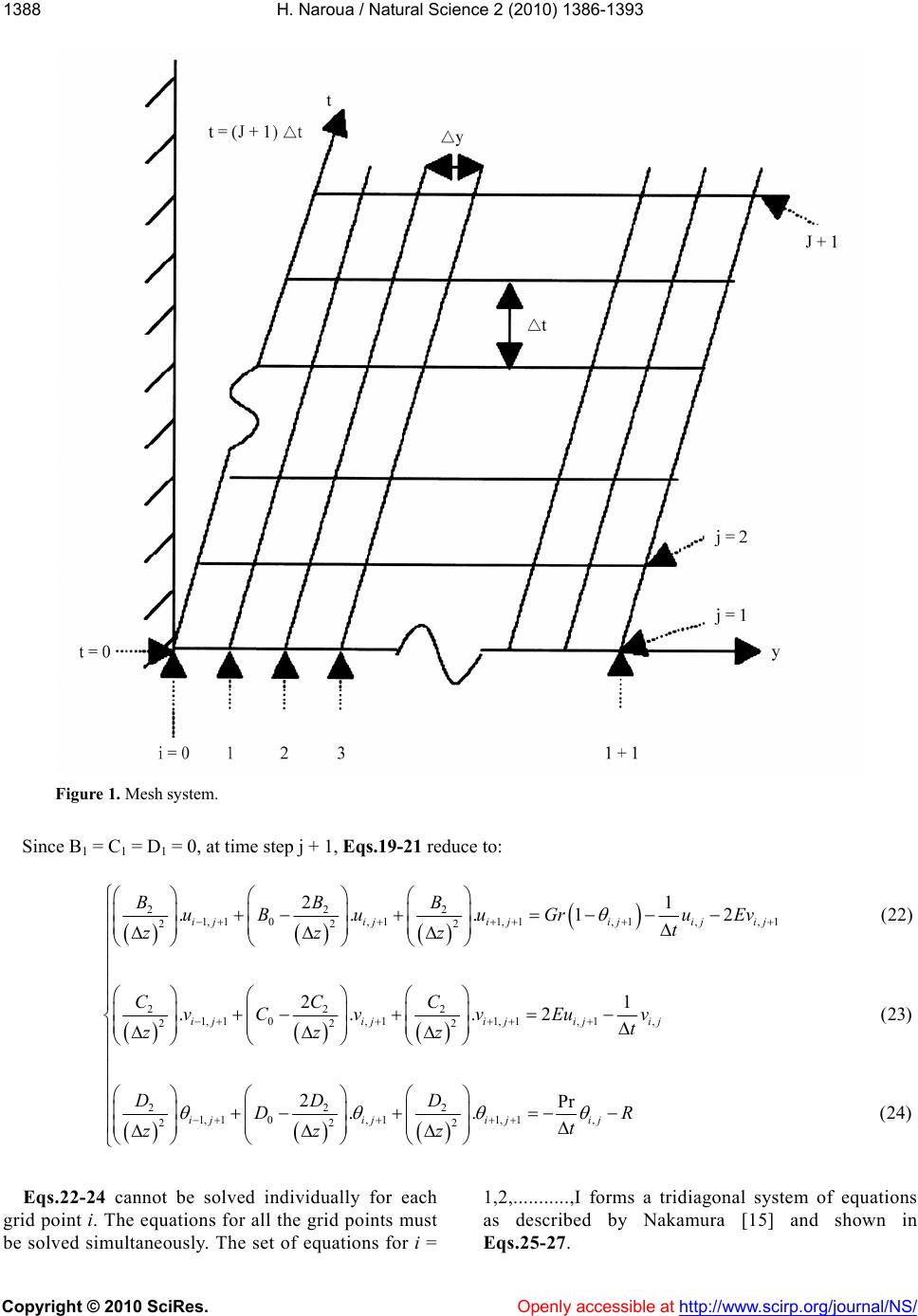 H. Naroua / Natural Science 2 (2010) 1386-1393 1388 Figure 1. Mesh system. Since B1 = C1 = D1 = 0, at time step j + 1, Eqs.19-21 reduce to: 222 1, 10, 11, 1,1,, 1 222 222 1, 10, 11,1, 1, 222 2 21 ... 12(22) 21 ...2 (23) i jiji jijijij i jijijijij BBB uB uuGruEv t zzz CCC vCvvEu v t zzz D Copyright © 2010 SciRes. Openly accessible at http:// www.scirp.org/journal/NS/ 22 0, 11, 1, 22 2Pr .. (24) iji jij DD DR t zz Eqs.22-24 cannot be solved individually for each grid point i. The equations for all the grid points must be solved simultaneously. The set of equations for i = 1,2,...........,I forms a tridiagonal system of equations as described by Nakamura [15] and shown in Eqs.25-27. 1, 1 2 i j z 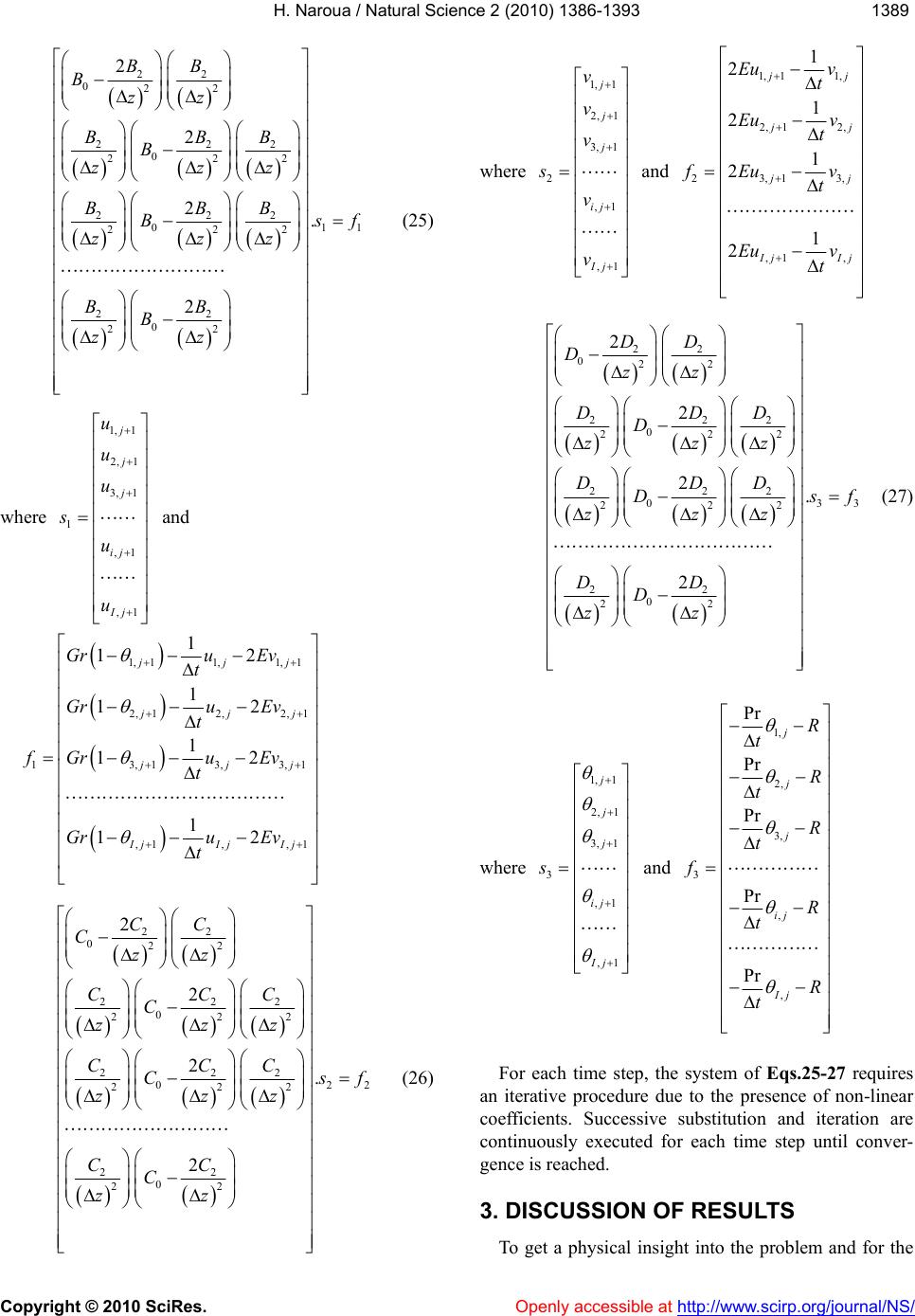 H. Naroua / Natural Science 2 (2010) 1386-1393 Copyright © 2010 SciRes. Openly accessible at http://www.scirp.org/journal/NS/ 1381389 22 022 222 0 222 222 01 222 22 0 22 2 2 2. 2 BB B zz BBB B zzz BBB Bs zzz BB B zz f 1 (25) where and 1, 1 2,1 j j u u 3, 1 1 ,1 ,1 j ij Ij u s u u 1, 11,1, 1 2, 12,2, 1 13, 13,3, 1 ,1, ,1 1 12 1 12 1 12 1 12 jj jj jj IjIj Ij Gru Ev t Gru Ev t fGru Ev t Gru Ev t j j j 22 0 222 0 222 222 02 222 22 0 22 2 2 2. 2 CC C zz CCC C zzz CCC Csf zzz CC C zz 2 (26) where v 22 1, 1 2,1 3,1 2 ,1 ,1 j j j ij Ij v v s v v and 1, 11, 2, 12, 23,13 ,1 , 1 2 1 2 1 2 1 2 jj , j j jI Eu v t Eu v t fEu v t Eu v t j 22 022 222 0 222 222 0 222 22 0 22 2 2 2. 2 DD D zz DDD D zzz DDD Ds zzz DD D zz 33 (27) where 1, 1 2,1 j j 3,1 3 ,1 ,1 j ij Ij s and 1, 2, 3, 3 , , Pr Pr Pr Pr Pr j j j ij Ij R t R t R t f R t R t For each time step, the system of Eqs.25-27 requires an iterative procedure due to the presence of non-linear ents. Succetion and iteratio are continuously executed for each time step until conver- gence is reached. 3. DISCUSSION OF RESULTS To get a physical insight into the problem and for the coefficissive substitun 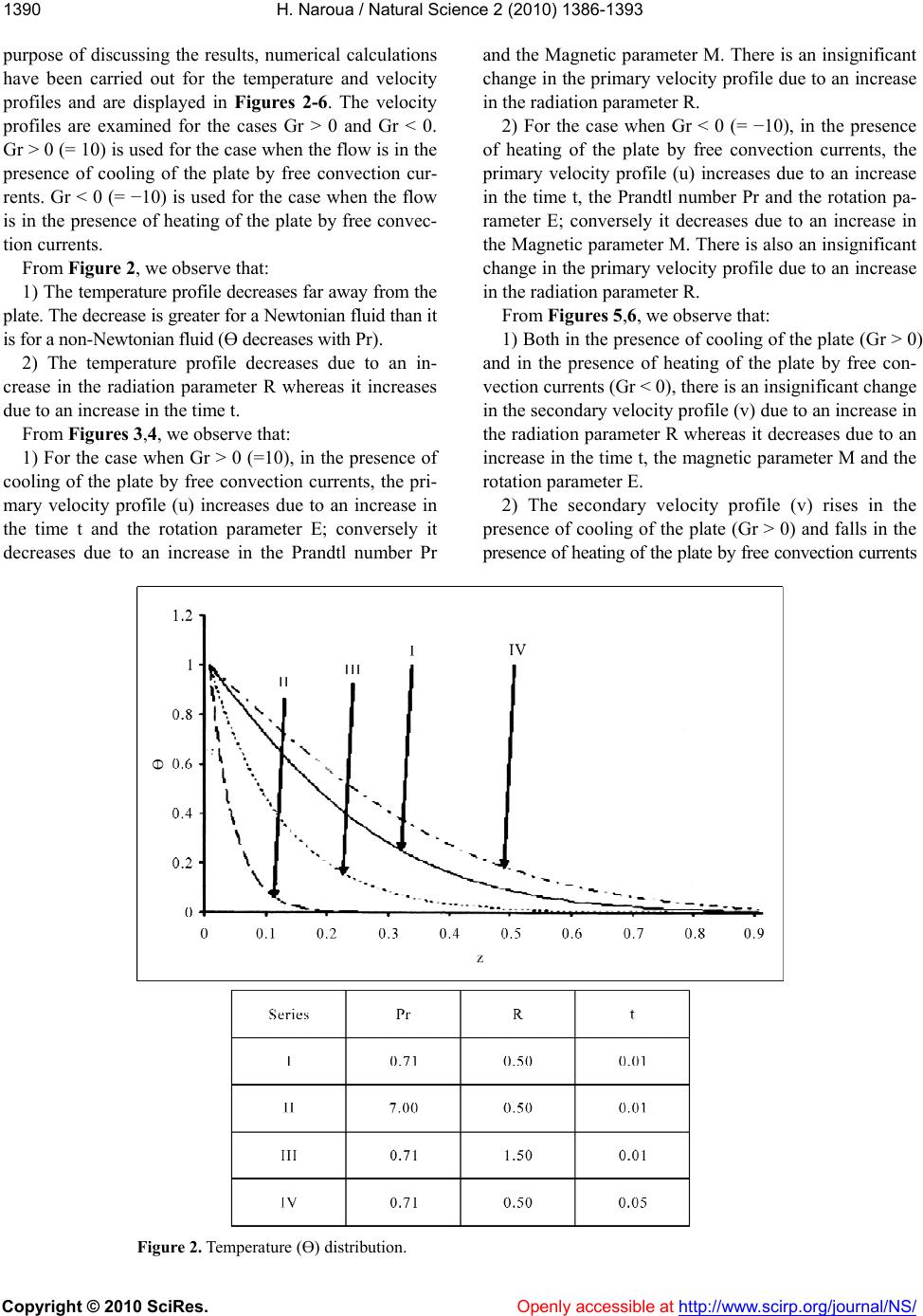 H. Naroua / Natural Science 2 (2010) 1386-1393 Copyright © 2010 SciRes. http://www.scirp.org/journal/NS/ 1390 purpose of discussing the results, numerical calculations have been carried out for the temperature and velocity profiles and are displayed in Figures 2-6. The velocity profiles are examined for the cases Gr > 0 and Gr < 0. Gr > 0 (= 10) is used for the case when the flow is in the presence of cooling of the plate by free convection cur- rents. Gr < 0 (= −10) is used for the case when the flow is in the presence of heating of the plate by free c tion currents. From Figure 2, we observe that: 1) The temperature profile decreases far away from the plate. The decrease is greater for a Newtonian fluid than it is for a non-Newtonian fluid (Ө decreases with Pr). 2) The temperature profile decreases due to an in- crease in the radiation parameter R whereas it increases due to an increase in the time t. From Figures 3,4, we observe that: 1) For the case when Gr > 0 (=10), in the presence of cooling of the plate by free convection currents, the pri- mary velocity profile (u) increases due to an increase in the time t and the rotation parameter E; conversely it decreases due to an increase in the Prandtl number Pr ease in onvection currents, the pr to an increase in From Figures 5,6, we observe that: 1) Both in the presence of cooling of the plate (Gr > 0) and in the presence of heating of the plate by free con- vection currents (Gr < 0), there is an insignificant change in the secondary velocity profile (v) due to an increase in the radiation parameter R whereas it decreases due to an increase in the time t, the magnetic parameter M and the rotation parameter E. 2) The secondary velocity profile (v) rises in the presence of cooling of the plate (Gr > 0) and falls in the presence of heating of the plate by free convection currents and the Magnetic parameter M. There is an insignificant change in the primary velocity profile due to an incr the radiation parameter R. 2) For the case when Gr < 0 (= −10), in the presence of heating of the plate by free c imary velocity profile (u) increases due the time t, the Prandtl number Pr and the rotation pa- rameter E; conversely it decreases due to an increase in the Magnetic parameter M. There is also an insignificant change in the primary velocity profile due to an increase in the radiation parameter R. onvec- Ө Figure 2. Temperature (Ө) distribution. Openly accessible at 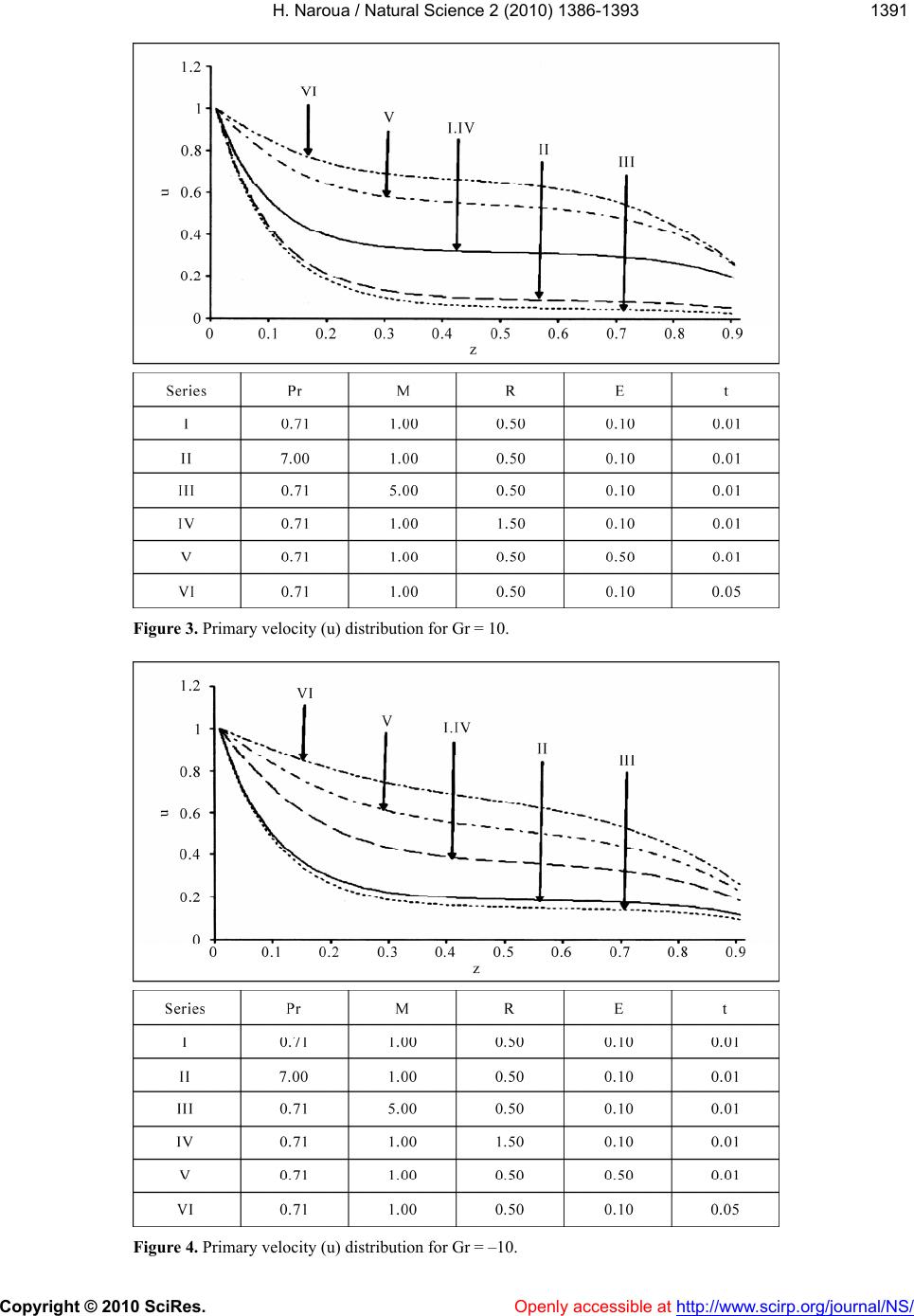 H. Naroua / Natural Science 2 (2010) 1386-1393 Copyright © 2010 SciRes. Openly accessible at http://www.scirp.org/journal/NS/ 1391391 Figure 3. Primary velocity (u) distribution for Gr = 10. Figure 4. Primary velocity (u) distribution for Gr = –10.  H. Naroua / Natural Science 2 (2010) 1386-1393 Copyright © 2010 SciRes. Openly accessible at http:// www.scirp.org/journal/NS/ 1392 Figure 5. Secondary velocity (v) distribution for Gr = 10. Figure 6. Secondary velocity (v) distribution for Gr = –10. 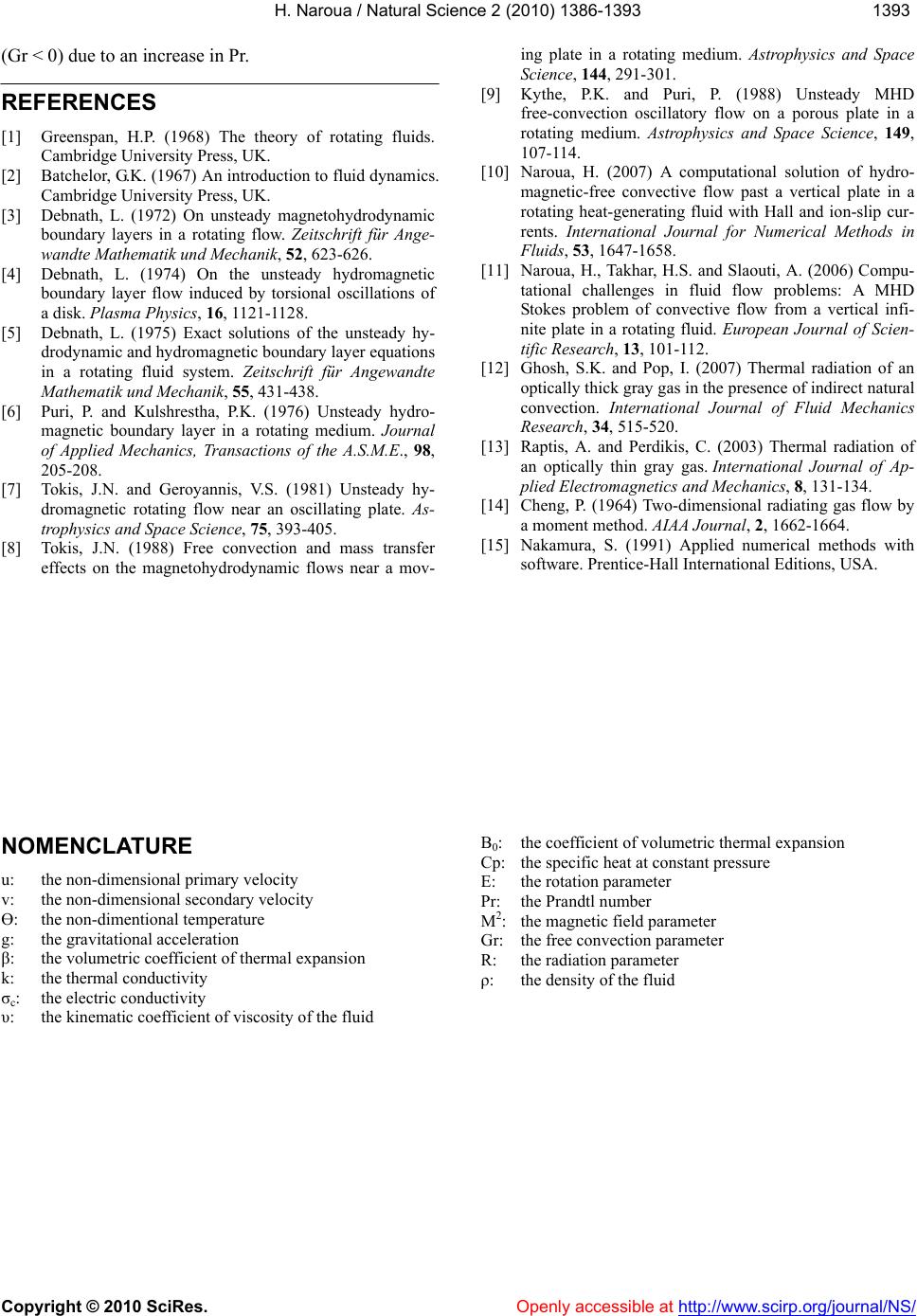 H. Naroua / Natural Science 2 (2010) 1386-1393 Copyright © 2010 SciRes. http:// www.scirp.org/journal/NS/ 1391393 (Gr < 0) due to an increase in Pr. REFERENCES [1] Greenspan, H.P. (1968) The theory of rotating fluids. Cambridge University Press, UK. [2] Batchelor, G.K. (1967) An introduction to fluid dynamics. Cambridge University Press, UK. [3] Debnath, L. (1972) On unsteady magnetohydrodynamic boundary layers in a rotating flow. Zeitschrift für Ange- wandte Mathematik und Mechanik, 52, 623-626. [4] Debnath, L. (1974) On the unsteady hydromagnetic boundary layer flow induced by torsional oscillations of a disk. Plasma Physics, 16, 1121-1128. [5] Debnath, L. (1975) Exact solutions of the unsteady hy- drodynamic and hydromagnetic boundary layer equations in a rotating fluid system. Zeitschrift für Angewandte Mathematik und Mechanik, 55, 431-438. [6] Puri, P. and Kulshrestha, P.K. (1976) Unsteady hydro- magnetic boundary layer in a rotating medium. Journal of Applied Mechanics, Transactions of the A.S.M.E., 98, 205-208. [7] Tokis, J.N. and Geroyannis, V.S. (1981) Unsteady hy- dromagnetic rotating flow near an oscillating plate. As- trophysics and Space Science, 75, 393-405. [8] Tokis, J.N. (1988) Free convection and mass transfer effects on the magnetohydrodynamic flows near a mov- ing plate in a rotating medium. Astrophysics and Space Science, 144, 291-301. [9] Kythe, P.K. and Puri, P. (1988) Unsteady MHD tory flow on a porous plate in a rotating medium. Astrophysics and Space Science, 149, 107-114. [10] Naroua, H. (2007) A computational solution of hydro- magnetic-free convective flow past a vertical plate in a rotating heat-generating fluid with Hall and ion-slip cur- rents. International Journal for Numerical Methods in Fluids, 53, 1647-1658. [11] Naroua, H., Takhar, H.S. and Slaouti, A. (2006) Compu- tational challenges in fluid flow problems: A MHD Stokes problem of convective flow from a vertical infi- nite plate in a rotating fluid. European Journal of Scien- tific Research, 13, 101-112. [12] Ghosh, S.K. and Pop, I. (2007) Thermal radiation of an optically thick gray gas in the presence of indirect natural convection. International Journal of Fluid Mechanics Research, 34, 515-520. [13] Raptis, A. and Perdikis, C. (2003) Thermal radiation of an optically thin gray gas. International Journal of Ap- plied Electromagnetics and Mechanics, 8, 131-134. [14] Cheng, P. (1964) Two-dimensional radiating gas flow by a moment method. AIAA Journal, 2, 1662-1664. [15] Nakamura, S. (1991) Applied numerical methods with software. Prentice-Hall International Editions, USA. NOMENCLATURE u: the non-dimensional primary velocity v: the non-dimensional secondary velocity Ө: the non-dimentional temperature g: the gravitational acceleration β: the volumetric coefficient of thermal expansion k: the thermal conductivity σc: the electric conductivity υ: the kinematic coefficient of viscosity of the fluid B0: the coefficient of volumetric thermal expansion Cp: the specific heat at constant pressure E: the rotation parameter Pr: the Prandtl number M2: the magnetic field parameter Gr: the free convection parameter R: the radiation parameter ρ: the density of the fluid free-convection oscilla Openly accessible at
|